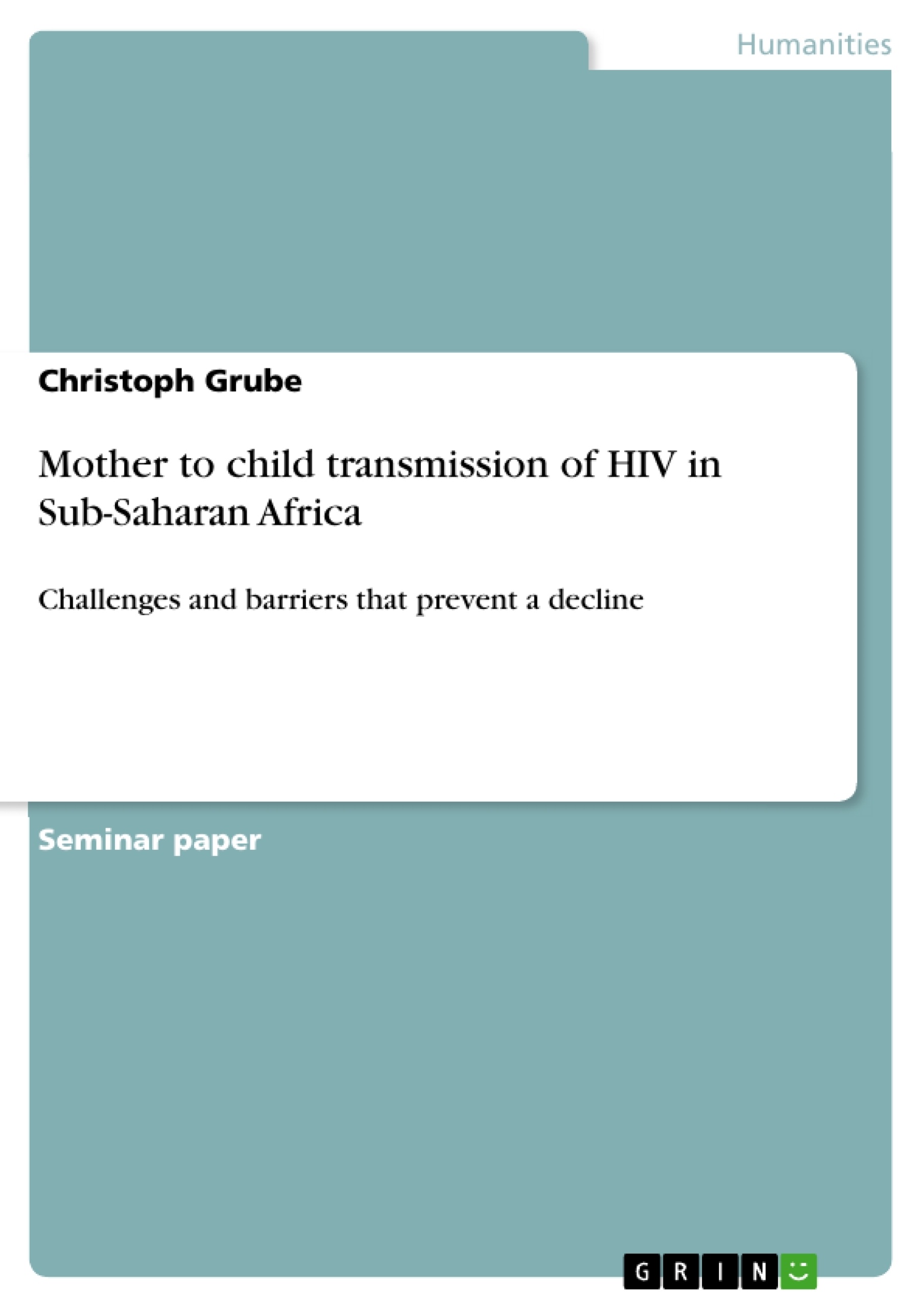This paper gives an overview of the mechanisms of mother to child transmission (MTCT) of HIV in Sub-Saharan countries and discusses why it still is a huge problem. It also shows what social and economic barriers occur when mothers, or to some extend people in general, try to access anti-retroviral treatments (ART). As research has shown, factors like social stigma still play a large role why so many people are not seeking help.
Sub-Saharan countries still have an unproportioned part of the global HIV infection compared to the rest of the globe. The most common form of getting infected by HIV is by heterosexual contact, followed by MTCT.
Even with the slowly declining numbers of infected people and people with no access to treatments, this still is a big issue that should be tackled and done more research on, especially on the mother to child transmission of HIV. MTCT contributes largely to the number of children affected by HIV by the age of ten and under.
The author intents to point out why this should be worked on more and why factors like education and reducing social stigma should be advanced in order to enable a faster decline of vertical transmission numbers. Furthermore, basic mechanisms of MTCT are going to be explained and how it possibly can be prevented in every stage of the pregnancy. Additionally, the author clarifies why social, cultural, and economic factors play such a big role in fighting against HIV. The paper aims to show, how all these factors tie together and what future research could be done in order to reduce the number of people getting affected by HIV, especially infants and young people.
Inhaltsverzeichnis (Table of Contents)
- The mechanisms of vertical transmission
- Prevention possibilities of mother to child transmission
- Pre-pregnancy and family planning
- Antenatal care and PMTCT
- Intrapartum care and PMTCT
- Postpartum care and PMTCT
- Factors that hinder the declining numbers of mother-to-child transmission
- Social Factors
- Economic Factors
- Cultural Factors
- Conclusion
Zielsetzung und Themenschwerpunkte (Objectives and Key Themes)
This paper aims to explore the complex issue of mother-to-child transmission (MTCT) of HIV in sub-Saharan Africa. It examines the mechanisms of transmission and highlights the challenges and barriers that hinder the decline of MTCT rates. The paper emphasizes the importance of addressing social, cultural, and economic factors that contribute to the problem.
- Mechanisms of MTCT: Understanding the pathways of HIV transmission from mother to child during pregnancy, childbirth, and breastfeeding.
- Prevention Strategies: Analyzing the effectiveness of various interventions, such as antiretroviral therapy (ART), family planning, and antenatal care.
- Social, Cultural, and Economic Barriers: Exploring the impact of poverty, stigma, and cultural beliefs on MTCT prevention and treatment.
- The Role of Education and Awareness: Examining the importance of education and public health campaigns in promoting HIV prevention and reducing the stigma associated with the disease.
- Future Research Directions: Identifying key areas for further research to enhance MTCT prevention and improve the lives of HIV-affected mothers and children.
Zusammenfassung der Kapitel (Chapter Summaries)
- The mechanisms of vertical transmission: This chapter explores the different stages of pregnancy, childbirth, and postpartum that can lead to HIV transmission from mother to child. It explains how factors like maternal health, mode of delivery, and breastfeeding contribute to the risk of infection.
- Prevention possibilities of mother to child transmission: This chapter examines the various interventions that have been developed to prevent MTCT, including antiretroviral therapy (ART), family planning, and different strategies for antenatal, intrapartum, and postpartum care.
- Pre-pregnancy and family planning: This chapter focuses on the importance of pre-pregnancy counseling and family planning as a crucial step in preventing MTCT. It highlights the challenges and opportunities associated with these interventions in sub-Saharan Africa.
- Antenatal care and PMTCT: This chapter discusses the role of antenatal care in detecting HIV-positive mothers and providing them with appropriate treatment and support. It explores the effectiveness of PMTCT programs in reducing the risk of vertical transmission.
- Intrapartum care and PMTCT: This chapter examines the critical role of intrapartum care in preventing HIV transmission during childbirth. It discusses the advantages of elective caesarean sections and other interventions that can minimize the risk of infection.
- Postpartum care and PMTCT: This chapter focuses on the importance of postpartum care in preventing HIV transmission through breastfeeding. It highlights the challenges of breastfeeding cessation and the need for alternative feeding methods.
Schlüsselwörter (Keywords)
Mother-to-child transmission (MTCT), HIV, sub-Saharan Africa, antiretroviral therapy (ART), prevention programs, social factors, cultural factors, economic factors, stigma, education, awareness, future research.
- Citation du texte
- Christoph Grube (Auteur), 2019, Mother to child transmission of HIV in Sub-Saharan Africa, Munich, GRIN Verlag, https://www.grin.com/document/488791



